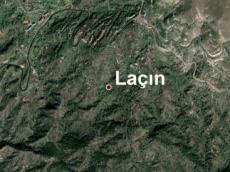|
|
TODAY.AZ / Society
Armenians destroy occupied Lachin region
18 May 2012 [12:42] - TODAY.AZ
 The Ministry of Ecology and Natural Resources of Azerbaijan issued a statement concerning the 20th anniversary of the occupation of Azerbaijan’s Lachin region by the Armenians.
The Ministry of Ecology and Natural Resources of Azerbaijan issued a statement concerning the 20th anniversary of the occupation of Azerbaijan’s Lachin region by the Armenians.The statement reads that there are sources of healing mineral waters like Turshsu, Galaderesi, Aganus, Hyrmanlar, Tigig, Nureddin, Nagdaly, Hajihanly in the territory of Lachin region, rich in natural resources.
Three deposits of mercury (Narzanly, Chilgezchay, Sarybulag) with 1124 tons of resources , Lachin limestone deposit of 4,457 tons of marble limestone deposit, Hojaz suitable for facing stones, with 2.533 thousand cubic meters of resources, two deposits of tuff (Agoglan and Ahmedly), which can produce building blocks, with 5.125 thousand cubic meters, Novruzlu clay deposits suitable for brick-ceramics, totaling 998 cubic meters of pumice in Gushchu with a margin of 2.144 thousand cubic meters of clay-sand mixture Upper Hakari River with a margin of 15.794 thousand cubic meters, agate deposits, reserves of 10 tons, and two deposits of jadeite, which reserves are 0.9 tons, three volcanic ash deposits, reserves of 10.449 thousand tons, deposits of mineral water Minkend volume to 4300 cubic meters / day are located in Lachin.
Lachin State Reserve covering 20 000 hectares was created in 1961 for the protection of rare natural complexes, and in 1987, Garagol State Reserve was launched in an area of 240 hectaresm, which preserve 68 species and 27 families of plants.
Lachin reserve saved rare species of fauna such as deer, mountain goat, wild boar, bear, francolin, partridge and ouzel. Red or golden oak, considered the most valuable types of wood decorated the forest of Hajishamly located in the reserve. This type of wood in Azerbaijan grew only in this forest.
The area of Lachin forest reserves lands is 33,285 hectares, 26,647 hectares (80.05 percent) of which were covered by forests. Pine, oak, hornbeam, birch, oriental hornbeam, ash tree, elm, acacia, willow, pear, poplar grew in these forests.
Two eastern plane trees of 400 years old grew in the area on the right bank of the Hakari River, and in the Zabukh village. Juniper, chestnut and yew trees were protected in the territory of the 1092-ha State Forest Fund.
/APA/
URL: http://www.today.az/news/society/107280.html
 Print version
Print version
Views: 1722
Connect with us. Get latest news and updates.
See Also
- 31 October 2025 [15:09]
Trial of Armenian citizens accused of war crimes continues in Baku Military Court - 31 October 2025 [12:55]
Agriculture remains strategic priority for both Bulgaria and Azerbaijan - 31 October 2025 [12:29]
Azerbaijan showcases post-conflict reconstruction as diplomats visit Jabrayil and Zangilan - 31 October 2025 [11:06]
Foreign envoys tour Azerbaijan’s Jabrayil and Zangilan, following President Aliyev’s visit - 31 October 2025 [10:19]
Baku hosts international conference on Belgium’s colonial past and its lasting impact - 30 October 2025 [14:24]
US invites Azerbaijan to join planned Gaza stability force - 30 October 2025 [10:42]
Baku reception honors 102nd Anniversary of Turkish Republic - 29 October 2025 [15:30]
Azerbaijan joins Rotterdam Convention - 29 October 2025 [12:20]
International parliamentary conference marks 30th anniversary of Azerbaijan’s Constitution - 29 October 2025 [12:11]
Leyla Aliyeva, Arzu Aliyeva participate in opening ceremony of Akhar-Bakhar National Park in Gakh
Most Popular
 Azerbaijan, Oman discuss deepening partnership during official talks
Azerbaijan, Oman discuss deepening partnership during official talks
 Azerbaijani Foreign Minister meets Omani counterpart to boost bilateral cooperation
Azerbaijani Foreign Minister meets Omani counterpart to boost bilateral cooperation
 BIG to host first international conference on Belgian colonialism
BIG to host first international conference on Belgian colonialism
 Azeri Light price declines
Azeri Light price declines
 Azerbaijan strengthens green financing framework for renewable energy projects, says official
Azerbaijan strengthens green financing framework for renewable energy projects, says official
 Locations for new energy storage systems revealed in Azerbaijan
Locations for new energy storage systems revealed in Azerbaijan
 BIAF-2025 set to showcase wide-ranging program
BIAF-2025 set to showcase wide-ranging program
